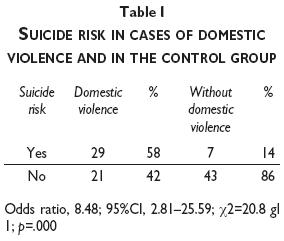Services on Demand
Journal
Article
Indicators
-
 Cited by SciELO
Cited by SciELO -
 Access statistics
Access statistics
Related links
-
 Similars in
SciELO
Similars in
SciELO
Share
Salud Pública de México
Print version ISSN 0036-3634
Salud pública Méx vol.55 n.6 Cuernavaca Nov./Dec. 2013
Cartas al editor
Suicide risk in female victims of domestic violence in Mexico
Karla Karina Gaviña Aguilar, Psic,(1) José María de la Roca Chiapas, D en CM,(2) Iliana Pamela Tapia Ibarra, Psic.(2)
(1) Coordinación de atención a la mujer, Sistema para el Desarrollo Integral de la Familia. Celaya, Guanajuato, México.
(2) Departamento de Psicología, División de Ciencias de la Salud, Universidad de Guanajuato. Guanajuato, México. Josema_delaroca@yahoo.com.mx
To the editor: The number of deaths by suicide in Mexico has increased in the past years becoming a serious public health issue.1,2 It has been identified that an unstructured family atmosphere can result in suicidal behavior. Perez and Garcia found marital problems as one of the most frequent reasons for suicidal behavior and it is considered that a dysfunctional marriage relationship is more suicide related for women than for men.3 Studies have shown that a fifth of women around the world are subjected to violence at some stage in their life and have twelve times more suicide attempts and high mortality rates compared with women who did not suffer from violence.4
The main goal of this study was to establish whether there is a correlation between domestic violence and suicide risk in female victims of domestic violence attending a group treatment in the Multidisciplinary Center for Comprehensive Care of Violence (CEMAIV). We selected a group of 50 women who had suffered domestic violence by their partners and assessed them using Plutchik's suicide risk scale. We also selected a control group of 50 women who were not victims of domestic violence and assessed them using the same test. For data analysis, we used χ2 and odds ratio tests, the confidence interval was set at 95%, and p values < .05 were considered significant.
We found that 58% of the women who were victims of domestic violence were at suicide risk, whereas 14% of the women in the control group were also at risk. Odds ratio test showed that women who suffered domestic violence were 8.48 times more likely to be at suicide risk compared with the control group (confidence intervals 2.81 to 25.59), as shown in table I.

This leads us to believe that in Mexico there is an association between domestic violence and suicide risk. We consider this association to be as high as to reflect the need to generate an intervention in the health system that aims to protect women who have this vulnerability. Furthermore, these results are relevant for health professionals working with women in order to detect suicide risk in these women and generate proposals for prevention and intervention for battered women.
References
1. Instituto Nacional de Estadística y Geografía. [Suicide statistics in the United Mexican States 2008]. [Accessed: December 11, 2011|. Available at: http://www.inegi.org.mx/prod_serv/contenidos/espanol/bvinegi/productos/continuas/sociales/suicidio/2008/suicidios_2008.pdf. [ Links ]
2. De la Roca-Chiapas J. Psychoanalysis and Epidemiology of suicide in the state of Guanajuato in the period 1997-2001. Reflections on youth groups. Public Health. 2008;50(1). [ Links ]
3. Perez S, García J. Suicide: [A Manual for the family, a glossary of psychological terms]. México: Universidad Autónoma de Querétaro; 2008. [ Links ]
4. Díaz E, Javier G. Violencia Intrafamiliar. Gac Med Mex 2003;139(4):354. [ Links ]













